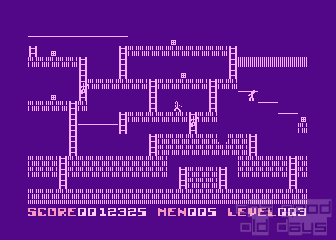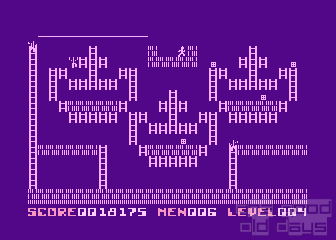In the Early Days™, computer games were still very much influenced by arcade games. Half of that is true for Lode Runner. The gameplay concerns a small figure running across platforms which are connected through ladders. It is collecting treasures while avoiding contact with the bad guys (the Bungelings). This sort of thing would work very well in an arcade environment.
What distinguishes this game from most others at the time is its size: There are so many levels, it just goes on and on and on and on. This is something which was commonly achieved at the time by looping the game around, i.e. simply repeating the already finished levels on a higher speed setting, for example. This game is different: The levels are all hand-made and very few people will ever have seen them all!

Using the aestetics of a Jump'n'Run game, each of Lode Runner's levels is actually a small puzzle. The treasures, which the player has to collect all to make the escape ladder appear, are distributed all over the single-screen level and getting a quick overview of possible routes, using ladders as well as horizontal hand-to-hand bars and considering the option to make death defying leaps downwards, is key. Making this challenge more complex is the ability of the Bungeling guards to pick up treasures themselves: only by assaulting them will the player be able to win the level. Which you could also interpret the other way around: As an advanced player, you can use the Bungelings to have treasures from otherwise hardly accessible areas of the level delivered to you.
Which involves the only 'weapon' the player carries: A kind of blowtorch (?) to dig holes into the ground (platforms). These can be used to temporarily trap enemies (which makes them lose their treasures and lets the player walk over then unharmed) or even to dig new routes through the levels (because the player can then jump down through them). Often, digging in the right spot is essential to win a level. Holes automatically fill up again after some seconds and some kinds of ground cannot be dug into.

The fun therefore primarily depends on the level design. Sure, not all of them are masterpieces, but generally, the quality is quite good. The game starts out with relatively simplistic designs which introduce the concepts discussed above while things slowly become more tricky over time – especially with the enemy AI not being too predictable.
Interestingly enough, an arcade version of Lode Runner was eventually made, making this one of the few games which went the opposite of the usual way. Numerous sequels and 're-imaginations' followed and there is still a somewhat active community making new levels to this very day. None of the later versions really managed to expand on the original in a noteworthy way, though. Above all, this shows the ingenious use of very simple means to create something not at all trivial.


Comments (1) [Post comment]